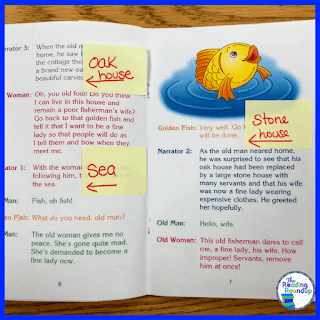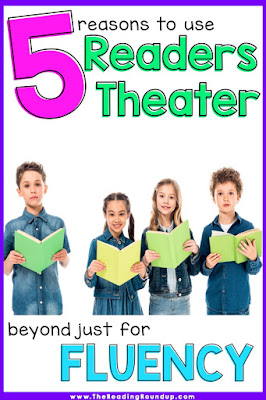Reader's Theater is an extremely effective and popular strategy for fluency practice. Students get to practice reading fluently in an authentic manner. But there are so many other skills you can teach using Reader's Theater!
5 Alternative Ways to use Reader's Theater
Read on to find 5 simple ways you can easily use Reader's Theater to enhance more than just students' reading fluency. By focusing on these additional skills, it improves students' overall reading ability which leads to a more expressive and fluent final performance of the Reader's Theater script!
Reader's Theater to Identify the Setting of a Story
Have your students look through the script to identify the parts of the story which refer to the setting. Reread those parts and write down the adjectives used to describe the setting. Discuss the word choice and determine where the story takes place. The students can then use Google images to find photos that best match the descriptions. This leads to rich discussions about which picture is best based on the evidence in the text! These photos can be added to a green screen app or simply displayed on your Smartboard behind students as they perform.
Reader's Theater for Vocabulary Development
Students may be unfamiliar with some of the words in the Reader's Theater scripts. This is a perfect opportunity to practice using context clues to determine the meaning of those words. Students may also find words that are hard for them to pronounce. Rather than making them stumble over the words during their performance, you can help them use context clues to find synonyms that are easier for them to accurately read. You can replace any of these difficult words in the script by writing in the easier word directly on the script or on a post-it note covering the challenging word. This allows students to feel more confident about their ability to read the text fluently as they perform for their peers.
Reader's Theater to Teach Comprehension
Reader's Theater is a great opportunity for students to work on a variety of comprehension skills. Students may practice making inferences about the characters, settings, and events. Reader's Theater scripts are also ideal for working on moral and theme. The students tend to find it easier to identify the moral in these texts because they are more personally invested in the story. They take on the role of their character which naturally deepens their overall comprehension more than when independently reading a passage out of a text.Reader's Theater to Analyze Character Traits
Reader's Theater is the perfect tool to use for character analysis. Work with students to identify the character traits and have them provide text evidence to support their inferences. Help students make inferences about how their character must be feeling in the story. Encourage students to draw faces in the margins or on post-it notes to show how their character is feeling. It's a perfect visual reminder to add the appropriate expression when performing the script!
Reader's Theater for Writing Practice
There are many opportunities to use Reader's Theater for writing practice. Allow students to rewrite some of their lines or change the ending. In fact, you may even want to have your students write an entire script themselves!





No comments:
Post a Comment
Leave a comment